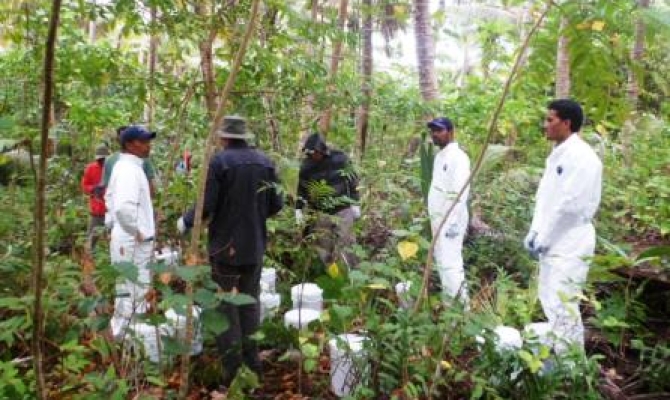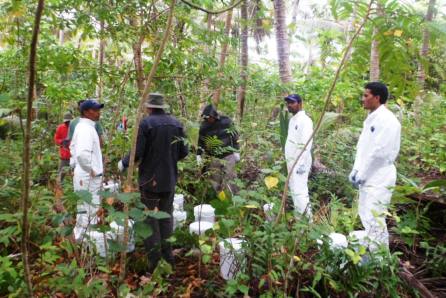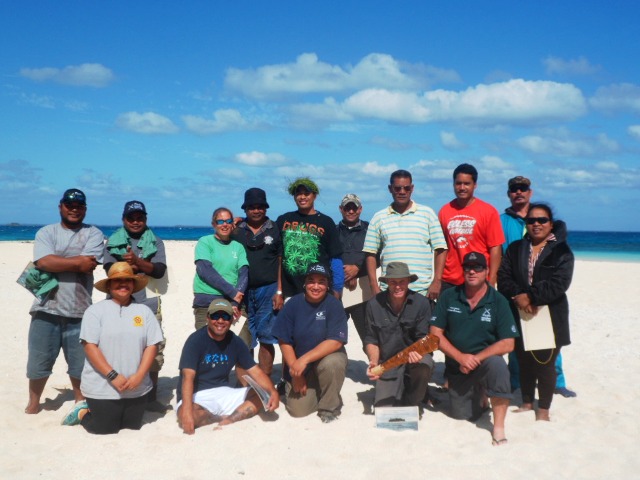
Biodiversity Conservation
The complete removal or eradication of rats from small islands and atolls was the focus for several Pacific island countries recently at a seven day practical training workshop.
The most common rat species across the Pacific islands are the ship rat, Norway rat and the Polynesian rat. While the rat may be the focus of popular cartoon shows and movies, the cuteness stops there.

Rats cause a multitude of problems for the Pacific islands. They eat bird eggs and young chicks, often driving the birds towards extinction along with insects, lizards and the seeds of native plants, all of which reduce ecosystem resilience. Rats also eat crops, reducing food security and affect human health through the spread of disease.
While large rodent eradication projects require substantial technical, financial and logistical support, there are many simpler smaller islands and atolls which can be addressed by local country staff following training and experience. The objective of the workshop was to provide the skills and experience necessary to implement a small scale (islands under 10 hectares) rodent eradication using both hand-held and bait-station application methods.
The workshop resulted in the islands of Malinoa and Motu tapu in the Tongatapu group being treated for rats by the participants. The training included planning the operation, rat bait toxicity and safety, surveying for rat species, non-target animals and potential harvesters, establishing a grid for laying bait with a compass, hand-spreading bait and using bait stations, and how to complete the eradication.
"This training will enable our Pacific island counterparts to implement effective rat eradication projects on small islands within their own country. With so many small islands in the Pacific, they offer a complimentary opportunity to eradication projects on larger islands that require a high level of logistics and resources and provide a low cost option to restore island biodiversity, particularly for seabirds," said Mr. David Moverley, the Invasive Species Adviser of the Secretariat of the Pacific Regional Environment Programme (SPREP).

"The process that Island Conservation has taken the participants through is safe and effective, involving the development of food webs to determine potential non-target impacts and identifying time periods where harvesting of food resources should be limited."
Local Tongan staff will complete the second and final application of bait on the islands in two weeks time. Due to the difficulty of identifying the presence of rats at low numbers, monitoring will take place in 2016 to determine the success of the eradication.
Hosted in the Kingdom of Tonga from 28 July to 4 August, the training was facilitated in partnership with Island Conservation under the UNEP/SPREP led GEFPAS "Prevention, control and management of invasive alien species in the Pacific islands" project and Fonds Pacifique funding for Wallis and Futuna. Participants were from Kiribati, Marshall Islands, Tonga and Wallis and Futuna.
The most common rat species across the Pacific islands are the ship rat, Norway rat and the Polynesian rat. While the rat may be the focus of popular cartoon shows and movies, the cuteness stops there.

Application of rat bait in the forest as part of the training - photo courtesy of Sosefo Malau
Rats cause a multitude of problems for the Pacific islands. They eat bird eggs and young chicks, often driving the birds towards extinction along with insects, lizards and the seeds of native plants, all of which reduce ecosystem resilience. Rats also eat crops, reducing food security and affect human health through the spread of disease.
While large rodent eradication projects require substantial technical, financial and logistical support, there are many simpler smaller islands and atolls which can be addressed by local country staff following training and experience. The objective of the workshop was to provide the skills and experience necessary to implement a small scale (islands under 10 hectares) rodent eradication using both hand-held and bait-station application methods.
The workshop resulted in the islands of Malinoa and Motu tapu in the Tongatapu group being treated for rats by the participants. The training included planning the operation, rat bait toxicity and safety, surveying for rat species, non-target animals and potential harvesters, establishing a grid for laying bait with a compass, hand-spreading bait and using bait stations, and how to complete the eradication.
"This training will enable our Pacific island counterparts to implement effective rat eradication projects on small islands within their own country. With so many small islands in the Pacific, they offer a complimentary opportunity to eradication projects on larger islands that require a high level of logistics and resources and provide a low cost option to restore island biodiversity, particularly for seabirds," said Mr. David Moverley, the Invasive Species Adviser of the Secretariat of the Pacific Regional Environment Programme (SPREP).

The workshop team in Tonga - photo courtesy of Sosefo Malau
"The process that Island Conservation has taken the participants through is safe and effective, involving the development of food webs to determine potential non-target impacts and identifying time periods where harvesting of food resources should be limited."
Local Tongan staff will complete the second and final application of bait on the islands in two weeks time. Due to the difficulty of identifying the presence of rats at low numbers, monitoring will take place in 2016 to determine the success of the eradication.
Hosted in the Kingdom of Tonga from 28 July to 4 August, the training was facilitated in partnership with Island Conservation under the UNEP/SPREP led GEFPAS "Prevention, control and management of invasive alien species in the Pacific islands" project and Fonds Pacifique funding for Wallis and Futuna. Participants were from Kiribati, Marshall Islands, Tonga and Wallis and Futuna.